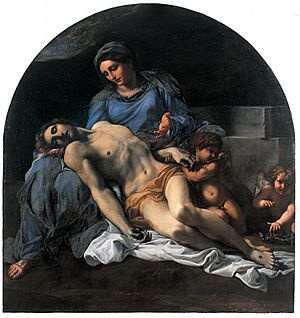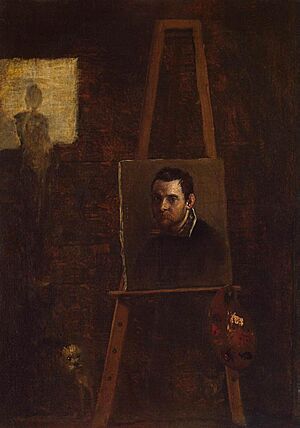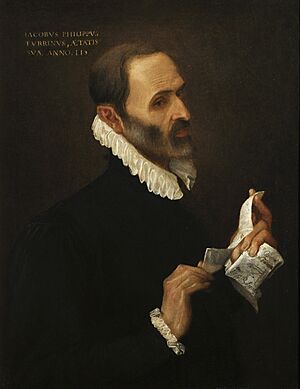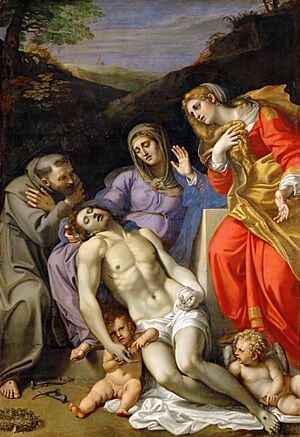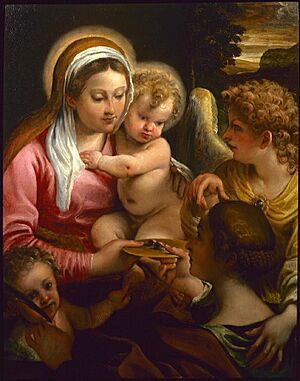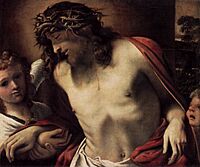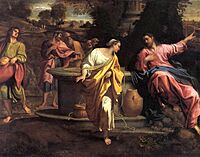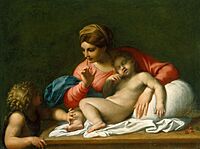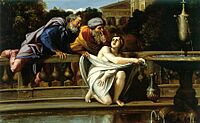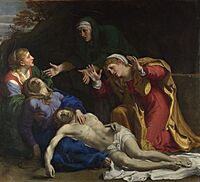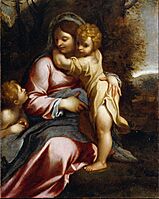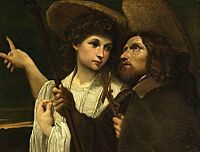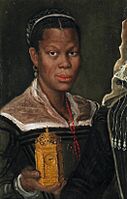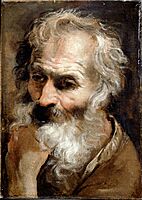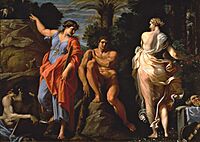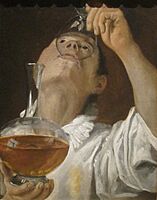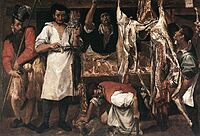Annibale Carracci facts for kids
Quick facts for kids
Annibale Carracci
|
|
|---|---|
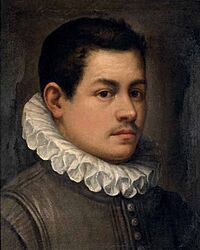
Self-portrait, c. 1580
|
|
| Born | November 3, 1560 |
| Died | July 15, 1609 (aged 48) Rome, Papal States
|
| Nationality | Italian |
| Known for | Painting |
| Movement | Baroque |
| Signature | |
Annibale Carracci (born November 3, 1560 – died July 15, 1609) was a very important Italian painter and teacher. He worked first in Bologna and later in Rome. Annibale, along with his brother and cousin, helped create the Baroque style of painting. They mixed ideas from different art styles and wanted to bring back the grand, classic look of ancient art, but with more energy and movement. Painters who worked with Annibale at the Palazzo Farnese in Rome became very influential in Roman painting for many years.
Contents
Becoming a Painter: Annibale's Early Life
Annibale Carracci was born in Bologna, Italy. He likely started learning to paint within his own family. In 1582, Annibale, his brother Agostino, and their cousin Ludovico Carracci opened their own art studio. It was first called the Academy of the Desiderosi, which means "those who desire fame and learning." Later, it was known as the Incamminati, meaning "progressives" or "those opening a new way."
This academy was seen as the first major art school to teach drawing from real life. It became a model for other art schools across Europe. The Carraccis focused on clear lines and drawing, like the famous artists Raphael and Andrea del Sarto from Florence. But they also loved the bright colors and softer edges seen in paintings by Venetian artists like Titian. Annibale and Agostino studied these works during their travels in Italy around 1580–81. This mix of different styles became a key feature of the Bolognese School of painting.
In their early works in Bologna, it's sometimes hard to tell which brother painted what. For example, the frescoes (wall paintings) about the story of Jason at Palazzo Fava (around 1583–84) are simply signed Carracci, showing they all worked together. Annibale also painted important religious works like the Baptism of Christ (1585) and the Assumption (1587).
Between 1589 and 1592, the three Carracci brothers worked together on frescoes about the Founding of Rome at Palazzo Magnani. Annibale continued to create many altarpieces and other paintings during this time.
Amazing Art at Palazzo Farnese
Because of their amazing frescoes in Bologna, Annibale was asked to decorate a huge palace in Rome called Palazzo Farnese. This request came from Cardinal Odoardo Farnese, whose brother was the Duke of Parma. In late 1595, Annibale and Agostino went to Rome. They started by decorating a smaller room, the Camerino, with stories of Hercules. This was a good choice because the room held a famous ancient statue of Hercules.
Annibale then spent a lot of time creating hundreds of sketches for his biggest project: the ceiling of the grand salon. He led a team painting frescoes called The Loves of the Gods. This ceiling is full of amazing details and creates an illusion of depth. It was inspired by the works of Michelangelo (like the Sistine Ceiling) and Raphael, but Annibale's work felt more personal and lively.
His work at Palazzo Farnese later inspired many other Baroque artists, who created grand, energetic frescoes. For over 100 years, the Farnese Ceiling was considered the best fresco painting of its time. It taught artists how to design heroic figures and how to plan their work. Annibale's many preparatory drawings became a key step for any artist wanting to create a large, important painting.
Carracci and Caravaggio: Different Styles
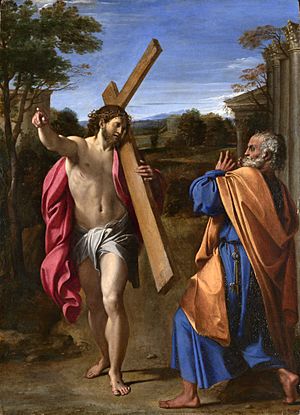
In the 1600s, an art critic named Giovanni Bellori praised Carracci as a perfect Italian painter. Bellori believed Carracci brought back the great traditions of Raphael and Michelangelo. However, Bellori didn't like Caravaggio's style as much. Caravaggio painted very realistically, sometimes showing people exactly as they were, even if they weren't "ideal" beauties. Bellori thought painters should show perfect beauty, not ordinary people from the streets.
Despite these different views, some art buyers liked both artists. Today, many people are fascinated by Caravaggio's rebellious image. But it's important to remember how much Carracci influenced art. Caravaggio rarely painted frescoes, which was considered a true test of a great painter. Carracci's best works are in fresco. Caravaggio's paintings often have dark backgrounds and are good for quiet altars, while Carracci's frescoes are bright and full of life, perfect for large, well-lit walls and ceilings.
The Farnese frescoes show a great joy for life and a new burst of energy. In a famous chapel in Rome, the Cerasi Chapel, many visitors focus on Caravaggio's paintings, often overlooking Carracci's Assumption of the Virgin altarpiece. Yet, Carracci was a true innovator. He brought new life to Michelangelo's fresco style and created powerful, vibrant scenes. For decades after, the grand walls and ceilings of palaces would be filled with the brilliant works of Carracci's followers, not Caravaggio's.
Later, some critics didn't like Baroque art in general, including Carracci's work. But Carracci was often spared because he was seen as someone who copied the admired Raphael and painted proper subjects like ancient myths in his Farnese frescoes.
Landscapes, Everyday Scenes, and Drawings
Annibale Carracci was very versatile. He painted many different types of subjects, including landscapes, everyday scenes (called genre art), and portraits. He even painted several self-portraits of himself at different ages. He was one of the first Italian painters to create paintings where the landscape was more important than the people in it. A great example is his The Flight into Egypt. His student, Domenichino, and later artists like Claude Lorrain, followed his lead in this style.
Carracci also had a less formal side. He is often given credit for inventing caricatures, which are drawings that exaggerate features for comic effect. His early genre paintings, like The Beaneater, show his keen observation of daily life and his free painting style. Biographers say he was so focused on his work that he didn't pay much attention to his clothes!
Later Life and Legacy
It's not clear how much Annibale painted after finishing the main gallery in the Palazzo Farnese. By 1606, he was struggling with a "heavy melancholic humor," which means he was dealing with a deep sadness or illness that made it hard for him to paint. In 1607, he couldn't finish a painting for the Duke of Modena. A note from 1608 shows he promised a student he would spend at least two hours a day in his studio, but there isn't much information about why he stopped painting.
Annibale Carracci died in 1609. He was buried, as he wished, near Raphael in the Pantheon in Rome. Many famous artists, like Bernini, Poussin, and Rubens, praised his work. Many of his assistants and students from the Palazzo Farnese project became leading artists in the following decades. These included Domenichino, Francesco Albani, and Giovanni Lanfranco, among others.
Carracci's Influence on Painting
The art of the Italian Renaissance and famous artists like Raphael, Michelangelo, Titian, and Veronese greatly influenced Carracci's use of colors. Carracci helped lay the groundwork for the start of Baroque painting. The art style before him, called Mannerism, had become a bit stiff. Baroque painting, thanks to artists like Carracci, brought back energy and combined ideas from many different art schools. Annibale's paintings were especially inspired by the bright colors and style of Venetian painters, particularly Paolo Veronese. Examples include his Madonna Enthroned with Saint Matthew and The Mystic Marriage of Saint Catherine of Alexandria.
- Religious subjects
- Portraits
- Mythological subjects
-
The Judgment of Hercules, 1596, National Museum of Capodimonte
- Food related paintings
-
The Beaneater, 1580–1590, Galleria Colonna, Rome
-
Butcher's Shop, 1580, Christ Church Picture Gallery, Oxford
-
The Butcher's Shop, 1580, Kimbell Art Museum
See also
 In Spanish: Annibale Carracci para niños
In Spanish: Annibale Carracci para niños


